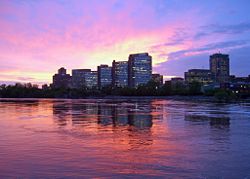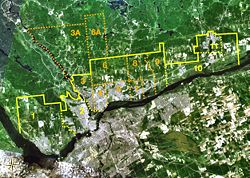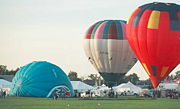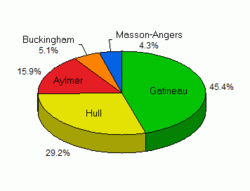Gatineau
| Gatineau, Quebec | |||
| — City — | |||
| Ville de Gatineau | |||
 |
|||
|
|||
| Motto: Fortunae meae, multorum faber [1]
|
|||
|
|
|||
| Coordinates(25, rue Laurier): | |||
| Country | |||
|---|---|---|---|
| Province | |||
| Administrative Region | Outaouais | ||
| Amalgamated | 2002 | ||
| Government | |||
| - Mayor | Marc Bureau | ||
| - Governing body | Gatineau City Council | ||
| - MPs | Lawrence Cannon, Richard Nadeau, Marcel Proulx | ||
| - MNAs | Maryse Gaudreault, Stéphanie Vallée, Charlotte L'Écuyer, Norman MacMillan, Benoît Pelletier | ||
| Area | |||
| - Total | 342.21 km² (132.1 sq mi) | ||
| Population (2006)[2] | |||
| - Total | 242,124 (Ranked 17th) | ||
| - Density | 662.3/km² (1,715.3/sq mi) | ||
| Time zone | Eastern (UTC-5) | ||
| Area code(s) | 819 | ||
| Access Routes |
|||
| Website: Ville de Gatineau | |||
Gatineau (as of 2006[update] census population 242,124)[2] is a city in western Quebec, Canada. It is situated on the northern bank of the Ottawa River, immediately across from Ottawa, Ontario, and is located within Canada's National Capital Region. Ottawa and Gatineau comprise a single Census Metropolitan Area.
Gatineau is coextensive with a territory equivalent to a regional county municipality (TE) and census division (CD) of the same name, whose geographical code is 81.
Contents |
History
- July 1, 1855: The cantons of Hull, Templeton, and Buckingham, as well as the villages of Aylmer and Buckingham are formed as part of the first municipal divisions in Quebec.
- February 23, 1875: The city of Hull is separated from Hull Canton.
- 1876: The village of Pointe-à-Gatineau separates from Templeton.
- 1877: The parish of L'Ange-Gardien separates from Buckingham Canton.
- 1880: The canton of Hull is divided into the cantons of Hull-South and Hull-West (now Chelsea).
- 1886: The canton of Templeton is divided into the cantons of Templeton-West and Templeton-East.
- 1889: The canton of Hull-East separates from Hull-West.
- 1890: The village of Buckingham changed its status to "city".
- 1897: The town of Masson separates from Buckingham Canton.
- March 23, 1897: The canton of Buckingham-South-East separates from Buckingham Canton.
- 1900: Great Fire of Hull
- 1909: The canton of Templeton-North (now Val-des-Monts) separates from Templeton-East.
- 1915: The village of Angers separates of L'Ange-Gardien.
- 1918: The canton of Buckingham-South-West separates from Buckingham Canton.
- 1920: The village of Deschênes separates from Hull-South. The village of Templeton and the canton of Templeton-East-Part-East separates from Templeton-East.
- 1933: The village of Gatineau separates from Templeton-West.
1939 to 1975
Gatineau was incorporated in 1939. From 1939 to 1975, the City of Gatineau encompassed a very small area compared to its current borders. Old Gatineau consisted of the area north of the Ottawa River opposite Kettle Island. Its western border was at present day Boulevard de la Cité and its eastern border went through present day Parc du Lac-Beauchamp. Its northern border was Boulevard Saint-René, but it was extended northward as the city expanded.
- 1957: Pointe-à-Gatineau becomes the town of Pointe-Gatineau. Gatineau changed its status to "city".
- 1964: Hull-South changed its name to Municipality of Lucerne.
- 1971: Hull-East changed its name to Town of Touraine.
- January 1, 1975: Hull changed its status to city. The towns of Pointe-Gatineau, Gatineau, and Touraine, the cantons of Templeton-West, Templeton-East, and Templeton-East-Part-East, as well as the village of Templeton amalgamate to form the City of Gatineau.
- January 1, 1975: The towns of Buckingham and Masson, the municipality of Notre-Dame-de-la-Salette, the cantons of Buckingham, Buckingham-South-East, and Buckingham-South-West, the parish of L'Ange-Gardien and the village of Angers amalgamate to form the town of Buckingham.
- January 1, 1975: Aylmer, Lucerne, and Deschênes amalgamate to form the town of Aylmer.
1975 to 2002
On January 1, 1975, the municipalities of Gatineau, Pointe-Gatineau, Touraine, Templeton, Templeton-Ouest and Templeton-Est were merged to form the City of Gatineau in an effort to improve municipal services and coordinate urban growth. With the 1975 amalgamation, Gatineau became the largest city in the Outaouais and fourth largest municipality in Quebec behind Montreal, Quebec City and Laval.
- May 17, 1979: Following public demand, the town of Masson and the municipalities of L'Ange-Gardien and Notre-Dame-de-la-Salette are separated from Buckingham.
- January 1, 1989: Following public demand, the municipality of Cantley separates from Gatineau. Nevertheless, Gatineau remained the fourth largest municipality in Quebec by population.
- January 1991: The Communauté Urbaine de l'Outaouais (Outaouais Urban Community) and Les Collines-de-l'Outaouais RCM are formed out of the Communauté Régionale de l'Outaouais (Outaouais Regional Community). [3]
- 1993: Masson changed its name to town of Masson-Angers.
- 2000: Bicentennial of city of Hull is celebrated.
- January 1, 2002: The cities of Aylmer, Buckingham, Gatineau, Hull, and Masson-Angers are amalgamated to form the new City of Gatineau. These 5 cities used to constitute the Communauté Urbaine de l'Outaouais (Outaouais Urban Community) supra-regional organization.[4] The former City of Gatineau was the largest of these municipalities, both in area and population.

Amalgamation
On January 1, 2002, the Parti Québécois government of Quebec amalgamated a number of municipalities throughout the Province, including the five former cities that constitute the current City of Gatineau (Aylmer, Hull, Gatineau, Buckingham and Masson-Angers). Hull was still considered the primary city within this region, although the former Gatineau had a larger population. Nonetheless, the name Gatineau was chosen for the new amalgamated municipality because it was more representative of the region (given that the former Gatineau county, the federal Gatineau Park, the Gatineau Hills, and the Gatineau River defined the area geographically, in a less restrictive manner than Hull). The Gatineau name was chosen, despite the fact that "Hull-Gatineau" was the most popular choice in opinion polls, because the transition committee excluded hyphenated names from the ballot, and despite the fact that the Hull name had represented the earliest urban development in the area. Also the fact that Gatineau is more French has likewise influenced the choice of largely French-speaking inhabitants.
On June 20, 2004, the current Liberal government of Quebec fulfilled a campaign promise by holding a referendum vote, giving the residents of the former cities the choice of separating from Gatineau. In order to separate, the residents of a former city required a double-win: more than 50% of the vote representing at least 35% of the electorate. The majority of the votes cast in Aylmer and Masson-Angers were in favour of separation, but they did not represent at least 35% of the electorate in their respective communities. The majority of voters in Buckingham and Hull, chose to remain part of Gatineau. The participation was very low, and the status quo can be partly attributed to the indifference of the citizens. There was no referendum in the former city of Gatineau.
Economy

A number of federal and provincial government offices are located in Gatineau, due to its proximity to the national capital, and its status as the main town of the Outaouais region of Quebec.
A policy of the federal government to distribute federal jobs on both sides of the Ottawa River led to the construction of several massive office towers to house federal civil servants in downtown Gatineau; the largest of these are Place du Portage and Terrasses de la Chaudière, occupying part of the downtown core of the city.
Recreation

Two important tourist attractions located in Gatineau are the Canadian Museum of Civilization and the Casino du Lac Leamy. In August, the Casino hosts an international fireworks competition which opposes four different countries with the winner being awarded a Prix Zeus prize for the best overall show (based on several criteria) and can return in the following year. At the beginning of September, on Labour Day weekend, Gatineau hosts an annual hot air balloon festival which fills the skies with colourful gas-fired passenger balloons.
There are many parks. Some of them are well gardened playgrounds or resting spaces while others, like Lac Beauchamp Park, are relatively wild green areas which often merge with the woods and fields of the surrounding municipalities. Streams of all sizes run through these natural expanses. Most of the city is on level ground but the Northern and Eastern parts lie on the beginnings of the foothills of the massive Canadian Shield, or Laurentian mountains. These are the "Gatineau Hills", and are visible in the background of the companion picture. One of Gatineau's urban parks, Jacques Cartier Park is used by the National Capital Commission during the popular festival, Winterlude.
Education
The city contains a campus of the Université du Québec, the Université du Québec en Outaouais (UQO).
It is also the home of two provincial junior colleges (or CEGEPs): the francophone CEGEP de l'Outaouais and the anglophone Heritage College. The National Autonomous University of Mexico (UNAM) has a campus in Gatineau.
Transportation
Gatineau has a municipal airport capable of handling small jets. There are Canada customs facilities for aircraft coming from outside Canada, a car rental counter and a restaurant. Various past attempts to provide regularly scheduled flights from Gatineau's airport had been unsuccessful. Most residents of Gatineau used the nearby Ottawa Macdonald-Cartier International Airport, or travel to Montréal-Pierre Elliott Trudeau International Airport in Montreal. Since September 2003 however Expresso has been operating regularly scheduled direct flights from Gatineau airport to Quebec city.
Ottawa and Gatineau have two distinct bus-based public transit systems with different fare structures, OC Transpo and the Société de transport de l'Outaouais. Tickets are not interchangeable between the two, and use of passes and transfers from one system to the other can require payment of a surcharge on certain routes (such as express lines).
Many Gatineau highways and major arteries feed directly into the bridges crossing over to Ottawa, but once there the roads land into the dense downtown grid or into residential areas, with no easy connection to the main highway in Ottawa, the East-West 417 or Queensway. This difficulty is further magnified by the lack of a major highway on the Quebec side of the Ottawa River connecting Gatineau to Montreal, Quebec, the metropolis of the province; most travelers from Gatineau to Montreal first cross over to Ottawa, and use Ontario highways to access Montreal. However, it is expected that Autoroute 50's gap between Gatineau and Lachute will be completed by 2010, making a new link between Gatineau and the Laurentians popular tourist area, and may serve as part of a Montreal by-pass by the north shore for Outaouais residents.
Key roads
Neighbourhoods

Gatineau City Council
The Gatineau Municipal Council (French: Le conseil municipal de Gatineau) is the governing body of the city of Gatineau, Quebec, Canada. It is composed of 17 city councillors and the mayor.
Media
Gatineau is the city of license for several television and radio stations, although many more stations licensed to Ottawa are also available in the area. Both cities are generally considered to constitute a single media market, and all of the region's broadcast stations transmit from the Ryan Tower site at Camp Fortune just north of Gatineau. All of the stations licensed directly to Gatineau broadcast in French.
Gatineau is also served primarily by daily newspapers published in Ottawa, including the French Le Droit and the English Ottawa Citizen, although a number of weekly community newspapers are published in Gatineau.
Population and demographics

According to the 2006 census the city of Gatineau had a population of 242,124. This was an increase of 6.8% compared to 2001. There were 104,607 private dwellings on a surface area of 342km² and a population density of 707 persons per km². Most of the citizens of the new city live in the urban cores of Aylmer, Hull and the former Gatineau. Buckingham and Masson-Angers are more rural communities.
The Quebec portion, the Gatineau Urban Area, has a population of 212,448 and an area of 136km². The Quebec regional portion of Gatineau Census Metropolitan Area (CMA) -- which includes the municipalities of Val-des-Monts (population 9,539), Cantley (7,928), La Pêche (7,477), Chelsea (6,703), Pontiac (5,238), L'Ange-Gardien (4,348), and Denholm (604) -- had a total population of 283,959.
The following statistics refer to the Quebec portion of the Ottawa – Gatineau CMA: Aboriginal status: ml/m/.m/peoples comprise 2.7% of the population. [5]
Languages: Counting both single and multiple responses, French was a mother tongue for 80.0% of residents in 2006, English for 13.9%, Arabic for 1.7%, Spanish for 1.1%, and Portuguese for 1.0%. [6] (Figures below are for single responses only.) [7]
| Mother Tongue | Population | Percentage |
|---|---|---|
| French | 220,970 | 78.5% |
| English | 35,580 | 12.6% |
| Arabic | 4,450 | 1.6% |
| Portuguese | 2,845 | 1.0% |
| Spanish | 2,820 | 1.0% |
| Chinese | 1,205 | 0.4% |
| Serbo-Croatian | 635 | 0.2% |
| Romanian | 620 | 0.2% |
| German | 590 | 0.2% |
| Vietnamese | 475 | 0.2% |
| Polish | 465 | 0.2% |
| Mother Tongue | Population | Percentage |
|---|---|---|
| Italian | 445 | 0.2% |
| Creole | 380 | 0.1% |
| Russian | 370 | 0.1% |
| Rundi (Kirundi) | 350 | 0.1% |
| Persian | 345 | 0.1% |
| Lao | 290 | 0.1% |
| Bosnian | 250 | 0.1% |
| Dutch | 235 | 0.1% |
| Serbian | 230 | 0.1% |
| Kinyarwanda | 225 | 0.1% |
| Hungarian | 220 | 0.1% |
| Mother Tongue | Population | Percentage |
|---|---|---|
| English and French | 3,345 | 1.2% |
| English and a non-official language | 240 | 0.1% |
| French and a non-official language | 940 | 0.3% |
| English, French and a non-official language | 115 | ~ |
Religion: About 83% of the population identified as Roman Catholic in 2001 while 7% said they had no religion and 5.5% identified as Protestant (1.3% Anglican, 1.3% United, 0.7% Baptist, 0.5% Jehovah’s Witnesses, 0.3% Lutheran, 0.2% Pentecostal, 0.2% Presbyterian). About 1% of the population identified as Muslim, 0.3% as Buddhist, and 0.2% as Eastern Orthodox. [8]
Visible minorities: The 2001 census found that 4.3% of the population self-identified as having a visible minority status, including, among others, about 1.3% who self-identified as Black, about 1.0% self-identifying as Arab, 0.5% as Latin American, 0.4% as Chinese, 0.3% as Southeast Asian, 0.2% as South Asian, and about 0.1% as Filipino. (Statistics Canada terminology is used throughout.)[9]
Immigration: The area is home to more than five thousand recent immigrants (i.e. those arriving between 2001 and 2006), who now comprise about two percent of the total population. 11% of these new immigrants have come from Colombia, 10% from China, 7% from France, 6% from Lebanon, 6% from Romania, 4% from Algeria, 3% from the United States and 3% from Congo. [10]
Internal migration: Between 2001 and 2006 there was a net influx of 5,205 people (equivalent to 2% of the total 2001 population) who moved to Gatineau from outside of the Ottawa - Gatineau area. There was also a net outmigration of 630 anglophones (equivalent to 2% of the 2001 anglophone population). Overall there was a net influx of 1,100 people from Quebec City, 1,060 from Montreal, 545 from Saguenay, 315 from Toronto, 240 from Trois-Rivières, 225 from Kingston, and 180 from Sudbury. [11]
Ethnocultural ancestries: Canadians were able to self-identify one or more ethnocultural ancestries in the 2001 census. (It should be noted that percentages may therefore add up to more than 100%.) The most common response was Canadian / Canadien and since the term 'Canadian' is as much an expression of citizenship as of ethnicity these figures should not be considered an exact record of the relative prevalence of different ethnocultural ancestries. 43.1% of respondents gave a single response of Canadian / Canadien while a further 26.5% identified both Canadian / Canadien and one or more other ethnocultural ancestries. 10.4% of respondents gave a single response of French, 1.1% gave a single response of Portuguese, 1.0% gave a single response of Irish, 0.9% gave a single response of Lebanese, 0.8% gave a single response of English, 0.7% gave a single responses of Québécois and 0.7% gave a single response of North American Indian. Counting both single and multiple responses, the most commonly identified ethnocultural ancestries were:
| 2006 % | 2001 % | |
|---|---|---|
| Canadian / Canadien | 69.6% | |
| French | 37.6% | |
| Irish | 7.6% | |
| English | 6.4% | |
| Scottish | 3.8% | |
| North American Indian | 3.4% | |
| German | 2.4% | |
| Portuguese | 1.4% | |
| Italian | 1.4% | |
| Québécois | 1.3% |
| 2006 % | 2001 % | |
|---|---|---|
| Lebanese | 1.2% | |
| Métis | 1.1% | |
| Polish | 0.8% | |
| Belgian | 0.6% | |
| Spanish | 0.5% | |
| Dutch (Netherlands) | 0.5% | |
| Chinese | 0.5% | |
| Haitian | 0.4% | |
| Ukrainian | 0.4% | |
| American (USA) | 0.4% |
The data to the left is also presented more geographically by Statistics Canada as: 70.7% North American, 37.8% French, 14.3% British Isles, 4.5% Aboriginal, 4.0% Southern European, 3.8% Western European, 1.9% Arab, 1.7% Eastern European, 1.0% East and Southeast Asian, 0.8% African, 0.7% Latin, Central and South American, 0.7% Caribbean and 0.5% Northern European.
(Percentages may total more than 100% due to rounding and multiple responses).
Notable persons from Gatineau
|
|
Communities
|
|
|
Geographic Location
 |
Cantley, Chelsea, Val-des-Monts, L'Ange-Gardien |
|
|||||
| Pontiac | Lochaber-Partie-Ouest | ||||||
| Ottawa River Bridges to Ottawa, Ontario |
See also
- Communauté Urbaine de l'Outaouais
- Communauté Régionale de l'Outaouais
- List of crossings of the Ottawa River
- List of communities in Quebec
- Mayor of Gatineau
- Municipal reorganization in Quebec
- Twin cities
References
- ↑ Ville de Gatineau (1933-1974) - Armoiries
- ↑ 2.0 2.1 "Population and dwelling counts, for Canada and census subdivisions (municipalities), 2006 and 2001 censuses - 100% data". 2006 Canadian Census. Retrieved on 2007-10-10.
- ↑ MRC des Collines-de-l’Outaouais
- ↑ L'Encyclopédie de L'Agora: Gatineau
- ↑ "Ottawa - Gatineau (Que. part - Partie Qc)". Aboriginal Identity (8), Sex (3) and Age Groups (12) for the Population of Canada, Provinces, Territories, Census Metropolitan Areas and Census Agglomerations, 2006 Census - 20% Sample Data. Statistics Canada (2008-01-15). Retrieved on 2008-02-06.
- ↑ "Ottawa - Gatineau (Que. part - Partie Qc)". Detailed Mother Tongue (148), Single and Multiple Language Responses (3) and Sex (3) for the Population of Canada, Provinces, Territories, Census Metropolitan Areas and Census Agglomerations, 2006 Census - 20% Sample Data. Statistics Canada (2007-11-20). Retrieved on 2008-02-06.
- ↑ "Ottawa - Gatineau (Que. part - Partie Qc)". Detailed Mother Tongue (186), Knowledge of Official Languages (5), Age Groups (17A) and Sex (3) for the Population of Canada, Provinces, Territories, Census Metropolitan Areas and Census Agglomerations, 2001 and 2006 Censuses - 20% Sample Data. Statistics Canada (2007-11-20). Retrieved on 2008-02-06.
- ↑ "Ottawa - Hull (Que. part - Partie Qc)". Religion (95A), Age Groups (7A) and Sex (3) for Population, for Canada, Provinces, Territories, Census Metropolitan Areas and Census Agglomerations, 1991 and 2001 Censuses - 20% Sample Data. Statistics Canada (2007-03-01). Retrieved on 2008-02-06.
- ↑ "Ottawa - Hull (Que. part - Partie Qc)". Visible Minority Groups (15) and Immigrant Status and Period of Immigration (11) for Population, for Canada, Provinces, Territories, Census Metropolitan Areas 1 and Census Agglomerations, 2001 Census - 20% Sample Data. Statistics Canada (2007-03-01). Retrieved on 2008-02-06.
- ↑ "title = Ottawa - Gatineau (Que. part - Partie Qc)". Immigrant Status and Period of Immigration (8) and Place of Birth (261) for the Immigrants and Non-permanent Residents of Canada, Provinces, Territories, Census Metropolitan Areas and Census Agglomerations, 2006 Census - 20% Sample Data. Statistics Canada (2007-12-04). Retrieved on 2008-02-06.
- ↑ "Ottawa - Gatineau (Que. part - Partie Qc)". Census Metropolitan Area of Residence 5 Years Ago (37), Mother Tongue (8), Immigrant Status and Period of Immigration (9), Age Groups (16) and Sex (3) for the Inter-Census Metropolitan Area Migrants Aged 5 Years and Over of Census Metropolitan Areas, 2006 Census - 20% Sample Data. Statistics Canada (2007-03-01). Retrieved on 2008-02-06.
External links
|
||||||||||||||
|
|||||||||||||||||
|
|||||